Giant pandas are among the most beloved and iconic animals in the world, captivating visitors with their distinctive black and white markings and endearing behaviors. However, caring for these rare bears in U.S. zoos represents one of the most complex, expensive, and diplomatically intricate animal husbandry challenges in modern zoological history. From specialized diets and habitat requirements to international conservation agreements and breeding programs, panda care demands extraordinary commitment from institutions fortunate enough to host these magnificent animals. Currently, only three U.S. zoos—the National Zoo in Washington D.C., Zoo Atlanta, and the San Diego Zoo—house giant pandas, each operating under carefully negotiated agreements with China, the pandas’ native homeland. Let’s explore the fascinating world of panda care in American zoos and the remarkable dedication required to ensure these animals thrive far from their native bamboo forests.
The Diplomatic Framework of Panda Conservation
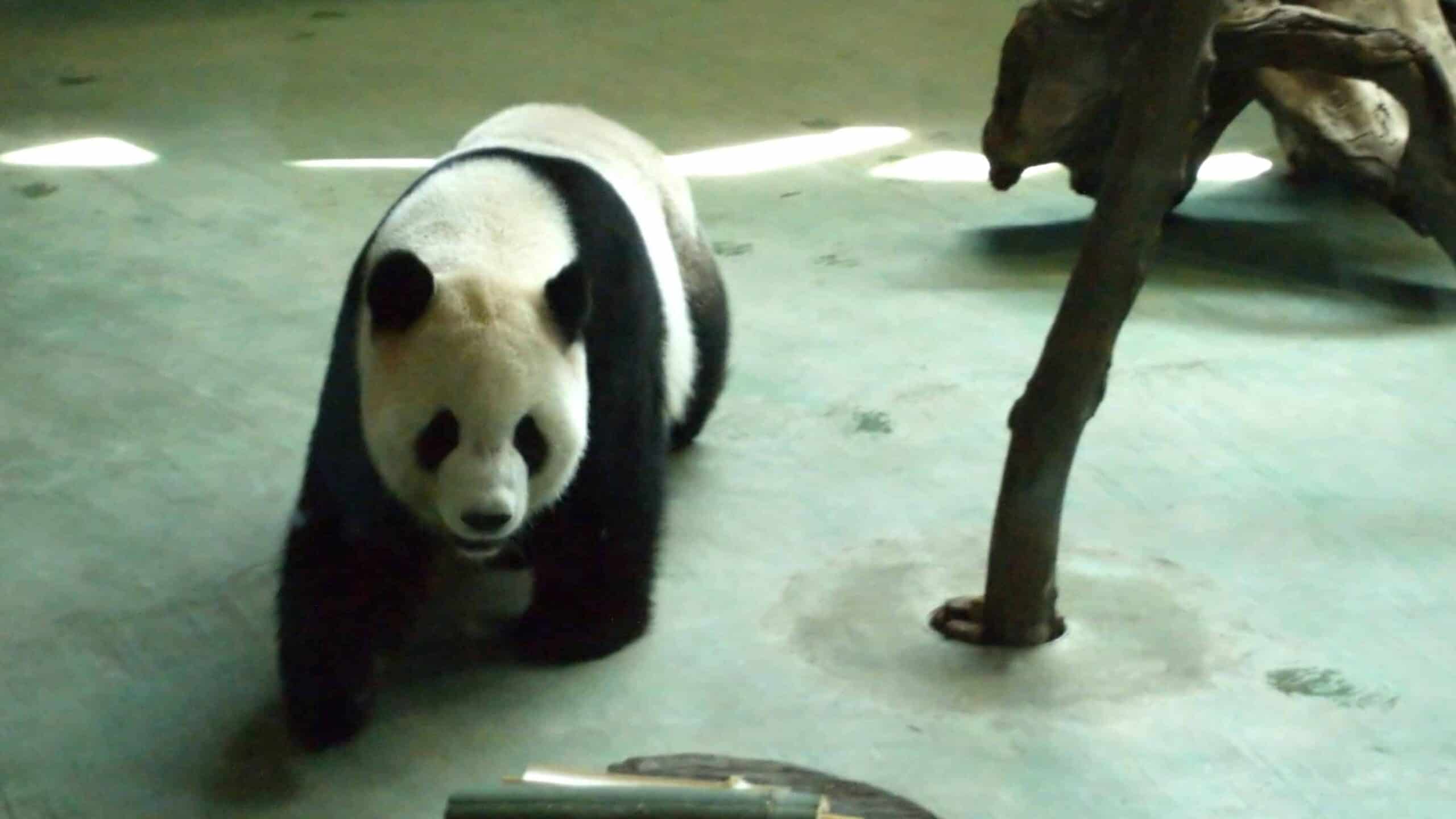
Before a U.S. zoo can even begin caring for pandas, years of diplomatic negotiations must take place. Giant pandas are not purchased but loaned through agreements between the Chinese government and the receiving institution. These agreements, typically lasting 10 years with potential extensions, involve substantial financial commitments, with zoos paying annual conservation fees averaging $1 million per panda pair. This arrangement, often called “panda diplomacy,” dates back to the 1970s when China began using pandas as goodwill ambassadors to build international relationships.
The conservation fees paid by U.S. zoos directly support China’s panda conservation efforts, including habitat protection, research initiatives, and breeding centers. Additionally, any cubs born during the loan period technically belong to China and may be recalled to Chinese breeding centers when they reach maturity, typically between 3-4 years of age. This complex diplomatic framework means that caring for pandas requires not just animal husbandry expertise but also careful international relationship management and substantial financial resources before the animals even arrive on American soil.
Creating Specialized Habitats

Designing and constructing suitable habitats for giant pandas represents one of the most significant investments for U.S. zoos. These specialized enclosures must replicate elements of the pandas’ natural environment while meeting their unique behavioral needs. Construction costs for state-of-the-art panda exhibits typically range from $8-10 million, with features including climate control systems that maintain temperatures between 65-75°F with moderate humidity, multiple outdoor yards with varying terrain, shallow pools for cooling, climbing structures, and private indoor quarters with specialized flooring and resting platforms.
Each habitat must accommodate the solitary nature of pandas while allowing for visual barriers that give the animals a sense of security. Zoos also install sophisticated air filtration systems to minimize disease risks and specialized waste management systems to handle the high volume of bamboo waste. The National Zoo’s Panda House, for example, includes over 18,000 square feet of indoor and outdoor space designed to provide environmental enrichment while allowing visitors to observe the animals without causing stress. This careful balance between visitor access and animal welfare represents a major design challenge unique to zoo-based conservation programs.
The Bamboo Challenge
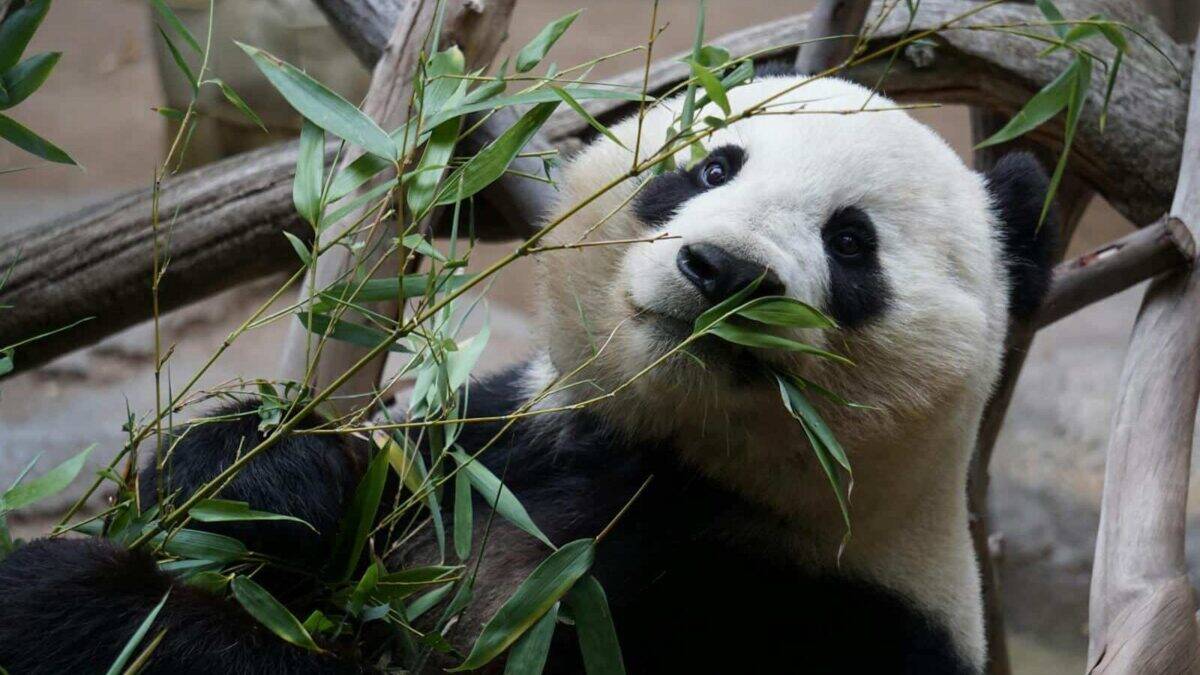
Perhaps no aspect of panda care is more demanding than meeting their dietary needs. Giant pandas consume 20-40 pounds of bamboo daily—approximately 99% of their diet—requiring zoos to maintain extensive bamboo cultivation programs or partnerships with local suppliers. The San Diego Zoo, for instance, maintains over 20 acres of bamboo plantations growing more than 20 different bamboo species to ensure variety and continuous supply. This represents an annual food cost of approximately $200,000 per panda, excluding the labor involved in harvesting, transporting, and preparing the bamboo.
Compounding this challenge is the pandas’ selective feeding behavior. They may suddenly reject previously favored bamboo varieties or parts, requiring keepers to quickly source alternatives. Pandas prefer different bamboo parts seasonally—shoots in spring, leaves in summer, and stems in winter—and have strong preferences for freshness, rejecting bamboo that’s been harvested more than 48 hours prior. Zoos must therefore harvest bamboo multiple times weekly and store it in specialized coolers to maintain freshness. Beyond bamboo, pandas receive nutritional supplements, occasional fruits as enrichment treats, and specially formulated biscuits containing vitamins and minerals to ensure complete nutrition.
The Specialized Care Team
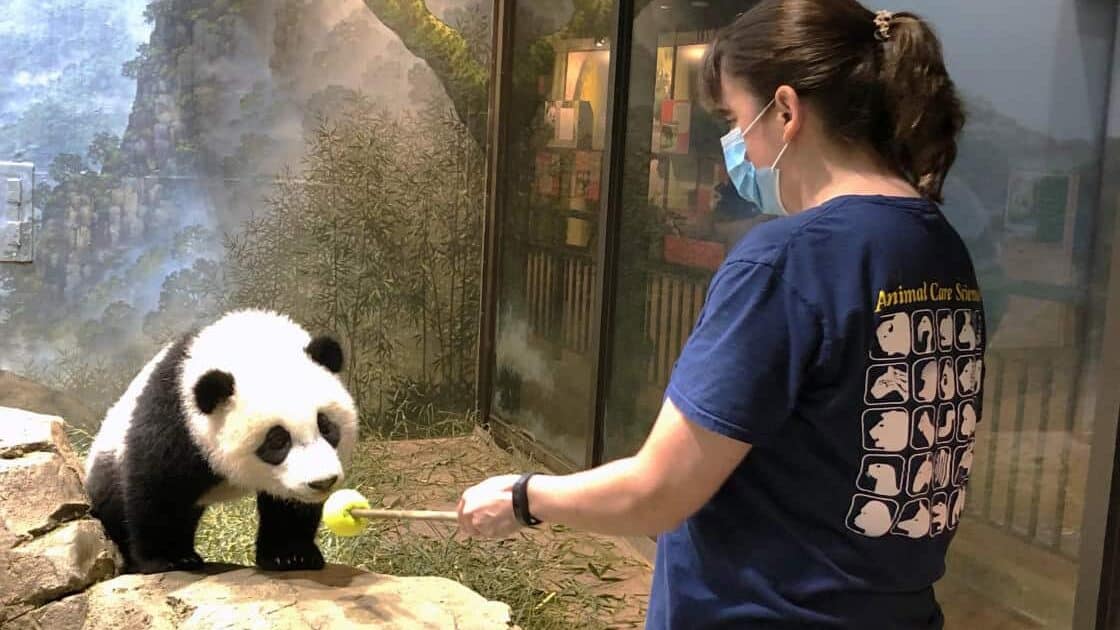
Caring for giant pandas requires a dedicated multidisciplinary team with specialized training. The core panda care team at a U.S. zoo typically includes 4-6 primary keepers who work exclusively with pandas, a veterinary team with expertise in panda health, nutritionists who monitor dietary needs, behavioral specialists who develop enrichment programs, and reproductive specialists who oversee breeding efforts. Many team members undergo training in China before the pandas arrive, learning specific husbandry techniques directly from experts at Chinese breeding centers.
The daily routine for panda keepers begins before dawn with exhibit cleaning and food preparation. Throughout the day, keepers conduct multiple feeding sessions, monitor behavior through direct observation and CCTV systems, implement enrichment activities, collect biological samples for health monitoring, and maintain detailed records of each animal’s behavior, food consumption, and elimination patterns. During breeding season or when cubs are present, the team expands and may work in shifts to provide 24-hour monitoring. This intensive staffing requirement represents an annual personnel cost of approximately $500,000-700,000 per zoo, making pandas among the most staff-intensive species in zoological collections.
Breeding Challenges and Reproductive Science

Giant pandas are notoriously difficult to breed in captivity, presenting one of the greatest challenges for U.S. zoos. Female pandas are fertile for only 24-72 hours annually, creating an extremely narrow breeding window that requires precise monitoring and timing. Zoos employ multiple methods to track female reproductive cycles, including behavioral observation, hormone analysis through urine and fecal samples, and ultrasound monitoring. When a female approaches estrus, the monitoring becomes around-the-clock, with hormone levels checked multiple times daily.
Many U.S. panda pregnancies result from artificial insemination rather than natural breeding, requiring specialized reproductive expertise. The pregnancy itself presents additional challenges—panda fetuses are tiny (about the size of a stick of butter at birth despite the mother weighing 200+ pounds), and “pseudopregnancy” (where females show all signs of pregnancy but aren’t actually pregnant) is common. Confirming pregnancy is difficult, and the gestation period varies widely from 3-6 months. Once cubs are born, they require intensive care as they’re highly underdeveloped, weighing just 3-5 ounces. The success of breeding programs at U.S. zoos, including the births of cubs like Mei Xiang’s at the National Zoo, represents significant achievements in reproductive science and international conservation collaboration.
Health Monitoring and Veterinary Care
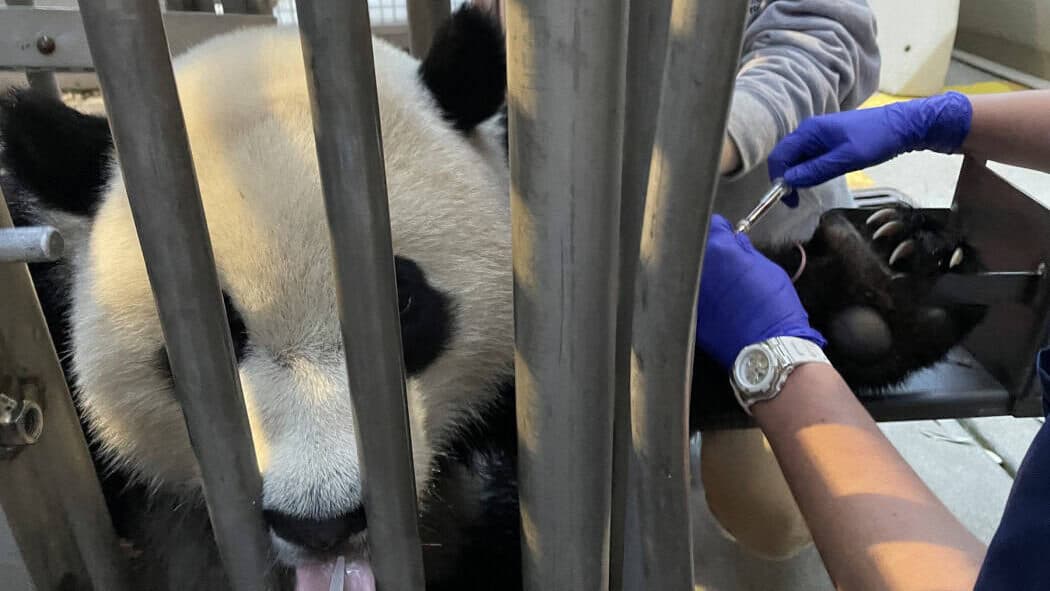
Providing comprehensive healthcare for giant pandas requires specialized veterinary expertise and equipment. U.S. zoos with pandas maintain dedicated veterinary teams familiar with panda physiology and common health concerns. Preventative care includes regular physical examinations, bloodwork, dental checks, and vaccination protocols specifically developed for pandas. Many procedures require training the pandas to voluntarily participate in their healthcare through positive reinforcement techniques, such as presenting limbs for blood draws or opening their mouths for dental examinations.
Zoos must maintain specialized diagnostic equipment, including digital radiography and ultrasound machines calibrated for panda anatomy. Veterinary facilities include quarantine areas, treatment rooms, and surgical suites capable of handling panda-specific procedures. Additionally, veterinary staff maintain close communication with colleagues in China, consulting on treatment protocols and sharing medical data to expand the collective knowledge of panda health. The veterinary costs alone for panda care can exceed $200,000 annually, including specialized equipment, medical supplies, diagnostic testing, and expert consultations—making pandas among the most expensive species to provide healthcare for in zoological settings.
Behavioral Management and Enrichment
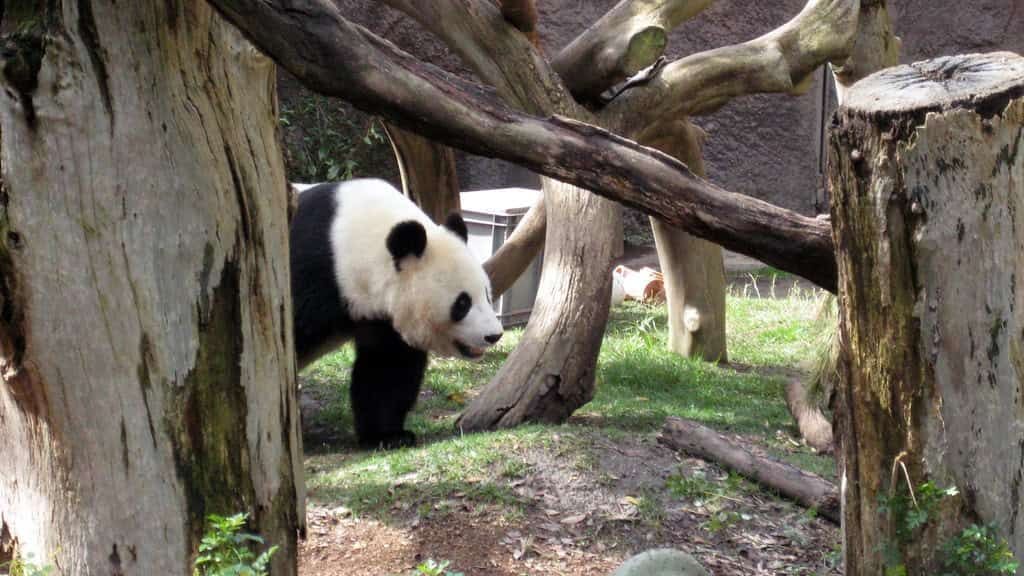
Maintaining the psychological well-being of giant pandas in captivity requires sophisticated behavioral management programs. U.S. zoos employ dedicated behavioral specialists who develop comprehensive enrichment schedules that stimulate natural behaviors and prevent stereotypic activities that might indicate stress. Enrichment takes many forms, including environmental enrichment (changing exhibit features to create novel experiences), sensory enrichment (introducing new scents, sounds, or textures), food-based enrichment (varying food presentation to encourage foraging), and cognitive enrichment (problem-solving activities like puzzle feeders).
Positive reinforcement training forms another crucial component of behavioral management, teaching pandas to voluntarily participate in husbandry and medical procedures. Keepers may spend years developing these training protocols, which reduce stress during necessary procedures like blood draws or ultrasounds. The San Diego Zoo pioneered many of these techniques, developing training programs that have been adopted internationally. These behavioral management programs require substantial daily staff time, specialized enrichment materials, and ongoing assessment to ensure effectiveness—representing both a significant time investment and a critical component of ethical panda care.
Research Responsibilities

U.S. zoos hosting pandas commit to substantial research programs as part of their loan agreements with China. These research initiatives focus on multiple areas, including reproductive biology, nutritional science, behavioral studies, genetic research, and veterinary medicine. Zoos typically dedicate specialized research staff and facilities to panda studies, often partnering with universities and research institutions to expand their capabilities. The findings from these research programs are shared internationally, contributing to global panda conservation knowledge.
Research responsibilities extend beyond the pandas themselves to include bamboo studies, investigating factors affecting nutritional content, growth patterns, and cultivation techniques. Additionally, zoos conduct visitor impact studies to understand how panda exhibits influence conservation awareness and support. Each U.S. zoo with pandas publishes multiple scientific papers annually based on their research, with findings presented at international conferences and shared with Chinese partners. These research commitments represent significant financial investments, with annual research budgets often exceeding $500,000, but they provide critical data that benefits wild panda conservation and captive management globally.
Public Education and Visitor Management

Giant pandas serve as powerful conservation ambassadors, drawing millions of visitors annually to the U.S. zoos that house them. Managing these visitors while providing meaningful educational experiences requires careful planning and substantial resources. Zoos develop comprehensive interpretive programs including multilingual signage, interactive displays, educational videos, guided tours, and specialized programming for school groups. These materials not only explain panda biology and behavior but also highlight conservation challenges and success stories.
The immense popularity of pandas necessitates specialized visitor management systems. The National Zoo, for example, implemented timed-entry passes during peak periods to manage the approximately 2.6 million annual visitors who come specifically to see the pandas. Exhibit design must balance visitor viewing opportunities with the pandas’ need for privacy, often incorporating one-way glass, elevated viewing platforms, and multiple vantage points to reduce crowding. Additionally, zoos train dedicated volunteer educators who engage visitors at panda exhibits, answering questions and providing information that deepens the educational impact of the experience. These public education efforts represent both a significant operational cost and a core mission of panda conservation programs in U.S. zoos.
Conservation Funding and Financial Commitments

The financial commitment required to care for giant pandas in U.S. zoos is extraordinary, with total costs averaging $2.6 million per panda annually. This includes the $1 million conservation loan fee paid directly to China, plus expenses for specialized staff, food, veterinary care, exhibit maintenance, and research programs. These costs make pandas among the most expensive animals to maintain in zoological collections, requiring dedicated funding streams and careful financial planning to sustain these programs over the 10+ year loan periods.
Zoos develop diverse funding strategies to support their panda programs, including corporate sponsorships, individual philanthropy, special fundraising events, and dedicated membership programs. The San Diego Zoo, for example, created the Panda Team program allowing donors to contribute directly to panda conservation efforts. Additionally, zoos leverage increased attendance and retail sales associated with pandas to generate revenue, with panda-themed merchandise often becoming top-selling items. Despite these revenue opportunities, panda programs typically operate at a financial loss for the hosting institutions, reflecting the zoos’ commitment to conservation over financial considerations. This financial reality means that only the largest, most financially stable zoos can realistically sustain panda conservation programs.
International Collaboration and Knowledge Exchange

Successful panda care in U.S. zoos depends on extensive international collaboration, particularly with Chinese institutions. Zoo staff regularly travel to China for training at facilities like the Chengdu Research Base of Giant Panda Breeding, while Chinese experts make reciprocal visits to U.S. zoos to assist with specialized procedures such as artificial insemination or neonatal care. These exchanges facilitate knowledge transfer and build critical relationships that support the overall conservation program. During significant events like births or medical emergencies, Chinese specialists may remain on-site at U.S. zoos for extended periods, providing expertise developed through decades of panda management.
Beyond direct collaboration with China, U.S. zoos participate in international consortiums like the Giant Panda Global Conservation Strategy, which coordinates conservation efforts across countries hosting pandas. Regular international conferences bring together panda specialists to share research findings, discuss management techniques, and develop standardized protocols. This global network ensures that advances in panda care are quickly disseminated across institutions, benefiting pandas worldwide. The collaborative nature of panda conservation represents a model for international species management, demonstrating how shared expertise can transcend political boundaries in service of wildlife conservation.
Future Challenges and Considerations

The future of giant panda care in U.S. zoos faces several evolving challenges. China has signaled intentions to gradually recall some pandas to support domestic conservation programs, potentially reducing the number of pandas in American zoos. Additionally, climate change threatens bamboo ecosystems worldwide, which could impact bamboo availability for captive pandas. Zoos are responding by expanding bamboo cultivation areas, researching bamboo species resilient to changing climate conditions, and developing contingency plans for food security.
Technological advances offer new opportunities for enhancing panda care, including improved reproductive technologies, remote health monitoring systems, and artificial intelligence applications for behavioral analysis. Meanwhile, shifting public attitudes toward animals in human care require zoos to continuously evolve their approaches to panda welfare and exhibit design, emphasizing natural behaviors and environments. As U.S. zoos navigate these challenges, they must balance the substantial investments required for panda conservation against other institutional priorities and conservation commitments. Despite these challenges, the success of panda conservation programs—with the global wild population increasing from fewer than 1,000 in the 1980s to over 1,800 today—demonstrates the value of these complex and resource-intensive care programs.
Caring for giant pandas in U.S. zoos represents one of the most complex, resource-intensive, and diplomatically intricate endeavors in modern zoological history. From the specialized habitats and bamboo cultivation programs to the multidisciplinary care teams and international research collaborations, every aspect of panda husbandry demands extraordinary commitment and expertise. The financial investment—averaging $2.6 million per panda annually—reflects both the logistical challenges of caring for these specialized eaters and the value placed on their conservation. Despite these challenges, the presence of pandas in American zoos has contributed significantly to global conservation efforts, scientific understanding, and public engagement with wildlife protection issues.
The success of panda conservation, transforming the species’ status from “endangered” to “vulnerable” in 2016, demonstrates the impact of these collaborative international efforts. As we look to the future, the care of pandas in U.S. zoos will continue to evolve, incorporating new scientific insights, technological advances, and changing perspectives on animal welfare. What remains constant is the extraordinary dedication required from the institutions and individuals committed to ensuring these iconic bears thrive far from their native bamboo forests, serving as living ambassadors for international conservation cooperation and the protection of endangered species worldwide.
- What It Takes to Care for a Panda in a U.S. Zoo - August 9, 2025
- Why Florida Is a Hotspot for Invasive Reptiles - August 9, 2025
- 10 Dog Breeds That Are Stronger Than They Look - August 9, 2025

